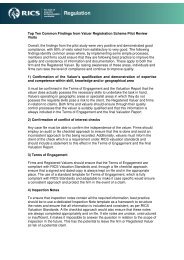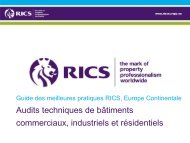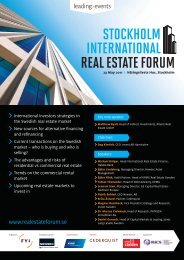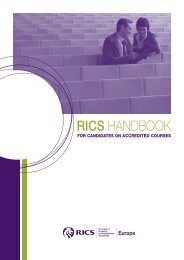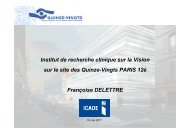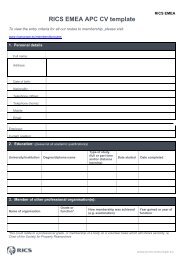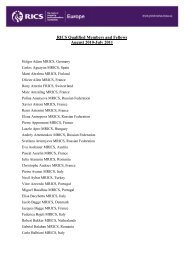Plant and Machinery Valuations- Vasileios Vichas ... - RICS Europe
Plant and Machinery Valuations- Vasileios Vichas ... - RICS Europe
Plant and Machinery Valuations- Vasileios Vichas ... - RICS Europe
- No tags were found...
Create successful ePaper yourself
Turn your PDF publications into a flip-book with our unique Google optimized e-Paper software.
<strong>RICS</strong> Hellas Conference27 March 2013Bodossaki Foundation Building of EFG EurobankAthens, GreecePLANT & MACHINERYVALUATION<strong>Vasileios</strong> <strong>Vichas</strong> F<strong>RICS</strong>, REVMechanical & Electrical Engineer N.T.U.A., M.Env.S.CEO of “MENTOR Surveyors – Valuers – Engineers S.A.”
<strong>Vasileios</strong> <strong>Vichas</strong> F<strong>RICS</strong>, REVCEO of “MENTOR Surveyors – Valuers – Engineers S.A.”• Mechanical & Electrical Engineer N.T.U.A., M.Env.S.• Member to the <strong>RICS</strong> <strong>Machinery</strong> & Business Assets Professional GroupBoard• Member of the Risk Management Forum of Eurapco• 24 years of experience in Risk Assessment, Loss Assessment, LossAdjustment, Valuation of Tangible Assets, Real Estate Valuation,Training of Personnel & Risk Mgt Studies• Previous experience in planning of mechanical & electrical installationsfor housing, industrial, sports <strong>and</strong> health, in evaluation of industrialinvestments & in inspections for the realization of implementation ofindustrial investments
MENTOR Surveyors – Valuers – Engineers S.A.a company of INTERAMERICAN GROUPmember of ACHMEA
CONTENTS1. <strong>RICS</strong> <strong>Machinery</strong> & Business AssetsProfessional Group2. <strong>Plant</strong> & Equipment Valuation: Remindingthe Main Guidelines of the Red Book3. Methodology4. Approaches to Value5. Common Practice – Examples5
1. <strong>RICS</strong> <strong>Machinery</strong> & Business AssetsProfessional GroupHome within <strong>RICS</strong> for those members who have arange of skills <strong>and</strong> expertise that allows them toadvise on the valuation <strong>and</strong> sale of both tangible<strong>and</strong> intangible assets throughout the world
1. <strong>RICS</strong> <strong>Machinery</strong> & Business AssetsProfessional Group<strong>Machinery</strong> <strong>and</strong> business assets surveyors providevaluation <strong>and</strong> agency services for all aspects ofmachinery <strong>and</strong> business assets in the industrial,commercial <strong>and</strong> government sectors
1. <strong>RICS</strong> <strong>Machinery</strong> & Business AssetsProfessional Group<strong>Machinery</strong> <strong>and</strong> business assets encompasses heavyindustrial machinery through to IT <strong>and</strong> telecomsequipment, <strong>and</strong> ancillary equipment <strong>and</strong> services
1. <strong>RICS</strong> <strong>Machinery</strong> & Business AssetsProfessional GroupMembers of the <strong>RICS</strong> <strong>Machinery</strong> <strong>and</strong> Business AssetsProfessional Group Board come from a variety ofbackgrounds <strong>and</strong> have a diverse range of skills <strong>and</strong>experience.The board has a number of working groups <strong>and</strong> alsoproduces regular progress reports.The board is always keen to hear from you <strong>and</strong> can becontacted on:T: +44 (0)870 333 1600E: mba.professionalgroup@rics.org
2. Reminding the main guidelines of the Red BookVPA 5: Valuation of <strong>Plant</strong> & EquipmentBACKGROUND• <strong>Plant</strong> <strong>and</strong> equipment forms a significant part of the global asset classknown as Tangible Fixed Assets, but with particular characteristicswhich distinguish them from most types of real property.• This fact influences the approach to the classification, measurement<strong>and</strong> reporting of value in respect of <strong>Plant</strong> <strong>and</strong> Equipment.• <strong>Plant</strong> <strong>and</strong> Equipment may also be physically affixed to real property inwhole or in part, <strong>and</strong> also capable of being moved or relocated.
2. Reminding the main guidelines of the Red BookVPA 5: Valuation of <strong>Plant</strong> & Equipment<strong>Plant</strong>: assets that are inextricably combined with others <strong>and</strong> that mayinclude items that form part of industrial infrastructure, utilities, buildingservices installations, specialised buildings, <strong>and</strong> machinery <strong>and</strong>equipment forming a dedicated assemblage;(e.g. Biodiesel production unit)
2. Reminding the main guidelines of the Red BookVPA 5: Valuation of <strong>Plant</strong> & Equipment<strong>Machinery</strong>: individual, or a collection of fleet of, machines that may beemployed, installed or remotely operated in connection with a user’sindustrial or commercial processes, trade or sector (a machine is anapparatus used for a specific process);(e.g. 4-colour, offset, printing machine)
2. Reminding the main guidelines of the Red BookVPA 5: Valuation of <strong>Plant</strong> & EquipmentEquipment: an all encompassing term for other assets such as sundrymachinery, tooling, fixtures, furniture <strong>and</strong> furnishings, trade fixtures <strong>and</strong>fittings, vehicles <strong>and</strong> loose tools that are used to assist the operation ofthe enterprise or entity.(e.g. Furniture of a resort hotel)
2. Reminding the main guidelines of the Red BookVPA 5: Valuation of <strong>Plant</strong> & EquipmentThe boundaries between these categories are not always easy to define,<strong>and</strong> the criteria used may vary according to:1. the particular market sector the assets serve,2. the purpose of the valuation <strong>and</strong>3. relevant national <strong>and</strong> international accounting conventions.
2. Reminding the main guidelines of the Red BookVPA 5: Valuation of <strong>Plant</strong> & EquipmentThe general principle is that assets installed primarily to provide servicesto the buildings should be valued as part of the property interest if theywould normally be included in the sale of the property <strong>and</strong> / or balancesheet classification.
2. Reminding the main guidelines of the Red BookVPA 5: Valuation of <strong>Plant</strong> & EquipmentIn a valuation for financial statements the treatment of fixed assets in theaccounts of the entity will normally provide some guidance regarding theparticular items of plant <strong>and</strong> equipment that may be separately valued.However, in many cases, the valuer will need to clarify with the client <strong>and</strong>advisors regarding the items that should be included in a valuation of theplant <strong>and</strong> equipment.
2. Reminding the main guidelines of the Red BookVPA 5: Valuation of <strong>Plant</strong> & EquipmentWhen different valuers are employed to carry out property <strong>and</strong> plantvaluations, careful liaison will be needed to avoid either omissions ordouble counting.
2. Reminding the main guidelines of the Red BookVPA 5: Valuation of <strong>Plant</strong> & Equipment<strong>Plant</strong> <strong>and</strong> equipment usually included in valuations of the propertyinterest• items associated with the provision of services (gas, electricity, water,drainage, fire protection <strong>and</strong> security) to the property;• equipment for space heating, hot water <strong>and</strong> air conditioning not integral toany process; <strong>and</strong>• structures <strong>and</strong> fixtures that are not an integral part of process equipment,for instance, chimneys, plant housings <strong>and</strong> railway tracks.
2. Reminding the main guidelines of the Red BookVPA 5: Valuation of <strong>Plant</strong> & Equipment<strong>Plant</strong> <strong>and</strong> equipment separately valuedExamples of ‘fixed assets’ include:• process <strong>and</strong> production plant <strong>and</strong> machinery;• fixtures <strong>and</strong> fittings;• office equipment, including computers;• office furniture;• vehicles <strong>and</strong> transport infrastructure; <strong>and</strong>• mobile plant.
2. Reminding the main guidelines of the Red BookVPA 5: Valuation of <strong>Plant</strong> & EquipmentBorderline items that may not always be regarded as ‘fixed assets’include:• product-dedicated items, for example, moulds, jigs <strong>and</strong> dies;• spare parts;• operating software, licenses <strong>and</strong> consents• stocks (inventory);• work in progress
2. Reminding the main guidelines of the Red BookVPA 5: Valuation of <strong>Plant</strong> & EquipmentAlthough intangible assets fall outside the definition of plant <strong>and</strong> equipment, the two assetclasses often operate in concert, which may have an impact on their discrete <strong>and</strong>/orcomposite values. In such cases, the valuer should establish appropriate assumptions inthis regard (preferably at engagement stage) <strong>and</strong> prior to reporting a valuation. Valuersshould also be aware of the fact that the definition of intangibles assets may vary relative toStatute, local practices <strong>and</strong> accounting convention. Examples of intangible assets include:• Licences <strong>and</strong> consents• Software• Commercial <strong>and</strong> administration records, drawings, designs <strong>and</strong> technical data;<strong>and</strong>• Licences, operating systems, goodwill, know how, patents, trademarks, br<strong>and</strong>names <strong>and</strong> other intellectual property.
2. Reminding the main guidelines of the Red BookVPA 5: Valuation of <strong>Plant</strong> & EquipmentEncumbered assets• It is common for plant <strong>and</strong> equipment to be subject to lease or financing arrangements.Such asset backed or based arrangements vary from a simple hire/ lease purchaseagreement through to complex, cross border tax driven, synthetic off balance sheetfinancing agreements. Hence, the valuer will need to establish the reporting basis <strong>and</strong> anyspecial assumptions at the time of engagement, or agreed <strong>and</strong> documented as anengagement progresses. In particular, the lease / finance agreement terms, stakeholders<strong>and</strong> wider commercial circumstances will need to be taken into account <strong>and</strong> the valuer mayneed to liaise with other advisors in this regard.
2. Reminding the main guidelines of the Red BookVPA 5: Valuation of <strong>Plant</strong> & EquipmentMaterial considerationsWhen valuing plant <strong>and</strong> equipment on the basis of market value, VS 3.2 requires anindication of whether the valuation assumes that the assets will remain in their workingplace, or are valued for removal (as a whole, or piecemeal). Further assumptions may alsobe required, depending upon the purpose of the valuation. Examples include:• how the asset is to be offered for sale, for example, as a whole or as individual items;• the assumed method of sale;• environmental issues• any restriction on sale method (e.g. lease conditions precludes auction)• whether the purchaser or vendor is to bear the costs of decommissioning or removal; <strong>and</strong>• whether allowance is made for any cost of reinstatement following removal <strong>and</strong>, if so, who isto bear the cost?
2. Reminding the main guidelines of the Red BookVPA 5: Valuation of <strong>Plant</strong> & EquipmentMany of the inspection requirements set out in VPS 2 can be readily adapted to plant <strong>and</strong>equipment assets. In order to prepare a valuation, the valuer first needs to establish matterssuch as:the Type, Specification, Capacity <strong>and</strong> Purpose off the Items,then consider matters such as:Age, Efficiency, Condition, Functional <strong>and</strong> Economic Obsolescence, <strong>and</strong>Estimated Total <strong>and</strong> Remaining Useful Economic Working Life.
2. Reminding the main guidelines of the Red BookVPA 5: Valuation of <strong>Plant</strong> & EquipmentRegulatory measures• Industrial activities are frequently subject to specific legislation <strong>and</strong> regulations. Noncompliancewith these legal requirements may result in the suspension of the right to usethe plant <strong>and</strong> equipment in question. Many of these are specific to the plant <strong>and</strong> processbeing considered <strong>and</strong> wider national <strong>and</strong> local Statute <strong>and</strong> regulations. Therefore, from avaluation perspective, the valuer must investigate the nature of the plant <strong>and</strong> activity, as wellas the purpose of the valuation <strong>and</strong> its extent, in determining how far the regulatorymeasure can, or might, affect the valuation.• Where there is doubt about compliance with any regulations affecting the value of <strong>Plant</strong> <strong>and</strong>equipment, the valuer should discuss the matter with the client <strong>and</strong> any related advisors <strong>and</strong>refer to the outcome in the report. This should be done either by agreeing to makeassumptions in the report, or to compliance undertakings as advised by the client <strong>and</strong> anyrelated advisors.
3. Classification <strong>and</strong> Description of <strong>Machinery</strong> <strong>and</strong> EquipmentFirst of all you need,“Crystal Clear Terms of Engagement”in compliance with st<strong>and</strong>ardsThen, aGeneral Overview• Be familiar with the industrial sector from the verybeginning• Review data of the plant before the on-site visit• Review the process with the appropriate plant personnel• Search & hire the appropriate collaborators
3. Classification <strong>and</strong> Description of <strong>Machinery</strong> <strong>and</strong> Equipment3.1. Account <strong>and</strong> Classes1. Production machinery (e.g. plastic injection molding machine)2. Support equipment (e.g. plastic scrap grinder)3. Motor control centers <strong>and</strong> switchgears4. Power wiring5. Process piping (e.g. compressed air, vacuum, water, steam,gases etc)6. Foundations <strong>and</strong> structural supports (structural steel, catwalks,ladders & platforms)7. Material h<strong>and</strong>ling <strong>and</strong> storage equipment (forklifts, loaders,conveyors, cranes, pallet movers, programmable inventorysystems etc)8. General plant equipment (benches, racks, lockers, ladders, fireextinguishers etc)
3. Classification <strong>and</strong> Description of <strong>Machinery</strong> <strong>and</strong> Equipment3.1. Account <strong>and</strong> Classes9. Laboratory & test equipment (microscopes, spectrographs,ovens etc)10. Office furniture, fixtures <strong>and</strong> equipment11. Computer equipment (personal, network, CAD, CAM)12. Tools13. Special tooling (dies, jigs, molds, templates etc)14. Construction in progress15. Special classes (leased, not inspected or away from premises,non operating assets etc)
3. Classification <strong>and</strong> Description of <strong>Machinery</strong> <strong>and</strong> Equipment3.2. Identification <strong>and</strong> Listing of <strong>Machinery</strong> <strong>and</strong> Equipment3.2.1. MacroidentificationThe method the valuer uses to answer these questions:• What the plant produce?• How is the product produced• What is the capacity of the plant?
3. Classification <strong>and</strong> Description of <strong>Machinery</strong> <strong>and</strong> Equipment3.2. Identification <strong>and</strong> Listing of <strong>Machinery</strong> <strong>and</strong> Equipment3.2.2. MicroidentificationFocuses on the listing of a single machine:• Br<strong>and</strong> name• Model number <strong>and</strong> size• Serial number• Capacity• Physical size• Age <strong>and</strong> condition
4. Approaches to Value4.1. Cost approach4.2. Comparison approach4.3. Income approach
4. Approaches to Value4.1. Cost ApproachThe logic behind the Cost Approach is the principle ofsubstitution:A prudent buyer will not pay more for an asset thanthe cost of acquiring a substitute asset of equivalentutility
4. Approaches to Value4.1. Cost ApproachThe valuer starts with the current replacement cost <strong>and</strong>then deducts for the loss in value caused by physicaldeterioration, functional obsolescence, <strong>and</strong> economicobsolescenceReplacement vs. Reproduction CostReproduction leads to a replicaReplacement asset would be the most economical newasset that could replace the service provided by thesubject
4. Approaches to Value4.1. Cost Approach: The methods4.1.1. The detail method4.1.2. Trending4.1.3. Cost-to-capacity4.1.4. Other engineering methods
4. Approaches to Value4.1. Cost Approach: The methods4.1.1. The detail or summation methodThe asset is itemized or “detailed” so that the sum of thecomponents reflects the cost new of the whole:Direct costs: Materials, labor, freight & h<strong>and</strong>ling, electrical,piping, foundations etc.Indirect costs: Engineering, administrative, accounting,consulting <strong>and</strong> legal fees, insurance, licenses & permits,security, equipment rental etc.Accuracyvs. Valuation cost increase
4. Approaches to Value4.1. Cost Approach: The methods4.1.2. The Trending methodCurrent Reproduction Cost New =(Current Index / Base Year Index) X Historical Cost• Indices weaknesses• Historical cost weaknesses• Improper for used assets• With great caution for periods in excess of ten (10) years
4. Approaches to Value4.1. Cost Approach: The methods4.1.2. The Trending method: An exampleNew Indices - NACE Rev.2 (*) Old Indices - NACE Rev.1 Product Description6252___006282___00Steel tanks, reservoirs<strong>and</strong> vessels(*) Data derived from Hellenic Statistical Authority
4.1. Cost Approach: The methods4. Approaches to Value4.1.2. The Trending method: An examplePurchase Date Historical Cost IndexTrendedHistorical Cost(1) (2) (3) (4) = (2) X (3)2007 3,550,000 1.085994123 3,855,2792008 1,150,000 1.051194539 1,208,8742009 600,000 1.022406639 613,4442010 80,000 1.025716929 82,0572011 715,000 1.0 715,0002012 0 1.0 0Totals 6,095,000 6,474,654
4. Approaches to Value4.1. Cost Approach: The methods4.1.3. The Cost-to-Capacity methodThe costs of similar plants vary with the size raised to somepower, expressed as follows:(C 2 / C 1 ) = (Q 2 / Q 1 ) pC: cost, Q: capacity, p: usually 0.6 to 0.7With great caution for large differences in capacity
4. Approaches to Value4.1. Cost Approach: The methods4.1.3. The Cost-to-Capacity method: An exampleEstimate the cost of an ethylene plant of 200,000T/y.It is known that the cost of an ethylene plant of 100,000T/yis €16,000,000.C 2 = C 1 (Q 2 / Q 1 ) pC 2 = €16,000,000 (200,000 / 100,000) 0.6 =C 2 = €24,251,465
4. Approaches to Value4.1. Cost Approach: The methodsHow to use them: An exampleSupposing we know the historical cost of a 5-year-old plant,that is similar to the subject, but of different capacity;moreover the subject has a separate division making aproduct not made by the 5-year-old plant.We may use:1. Trending method to reflect the current cost of the 5-year-old plant2. Cost-to-capacity method to establish the plant size relationship<strong>and</strong>3. Detail method to add the components of the separate division
4. Approaches to Value4.1. Cost Approach: DepreciationTypes or Causes of Depreciation1. Physical deterioration2. Functional obsolescence3. Economic obsolescence
4. Approaches to Value4.1. Cost Approach: DepreciationPhysical DeteriorationThe loss in value or usefulness of an asset due to theusing up or expiration of its useful life caused by wear<strong>and</strong> tear, deterioration, exposure to various elements,physical stresses, <strong>and</strong> similar factorsCurable vs. Incurable physical deterioratione.g. Patching a crude oil tank bottom vs. Aging of material
4. Approaches to Value4.1. Cost Approach: DepreciationPhysical Deterioration: Measuring it (%)Use / Total Usee.g. Normal physical life of a machine = 100,000hSubject machine has logged = 40,000hPhysical Deterioration = 40,000 / 100,000 = 40%
4. Approaches to Value4.1. Cost Approach: DepreciationPhysical Deterioration: Measuring it (%)Age / LifeEffective Age / (Effective Age + Remaining Physical Life)e.g. Effective age of an asset = 8yRemaining physical life= 12yPhysical Deterioration = 8 / (8 + 12) = 8 / 20 = 40%Chronological age vs. Effective age
4. Approaches to Value4.1. Cost Approach: DepreciationFunctional ObsolescenceThe loss in value or usefulness of an asset caused byinefficiencies or inadequacies of the asset itself, whencompared to a more efficient or less costly replacementasset that new technology has developed.Symptoms suggesting the presence of functional obsolescence areexcess operating cost, excess construction (excess capital cost), overcapacity,inadequacy, lack of utility, or similar conditions
4. Approaches to ValueFunctional Obsolescence: An exampleAnnual excess operating costs of subject machineof 10-year remaining life3,070€Less taxes @26% -798€Annual excess operating costs after taxes 2,272€PV factor @10% for 10 years 6.144567Operating Obsolescence 13,959€Rounded 14,000€
4. Approaches to Value4.1. Cost Approach: DepreciationEconomic or External ObsolescenceThe loss in value or usefulness of a property caused byfactors external to the asset, such us increased cost ofraw materials, labor, or utilities (without an offsettingincrease in product price); reduced dem<strong>and</strong> for theproduct; increased competition; environmental or otherregulations; inflation or high interest rates; or similarfactors
4. Approaches to Value4.1. Cost Approach: DepreciationEconomic or External ObsolescenceThe difficulty in measuring the full effect of economicobsolescence is one of the weaknesses of the costapproach, taking into account that outside influencesaffect an entire business (all tangible <strong>and</strong> intangibleassets), rather than individual assets.Income approach helps to identify the existence ofeconomic influences to value.
4. Approaches to Value4.1. Cost Approach: DepreciationEconomic Obsolescence due to InutilityInutility as a percentage = [1 – (Capacity B / Capacity A) p ]Capacity A = rated or design capacityCapacity B = actual production
4. Approaches to Value4.1. Cost Approach: DepreciationEconomic Obsolescence due to Inutility: An exampleProduction line 3 years old, excellent condition, state of the artDesign capacity = 1,000 units/dayActual operation = 750 units/day (due to dramatic increase in foreigncompetition)Inutility as a percentage = [1 – (750 / 1,000) 0.7 ] X 100 = 18.2%
4. Approaches to ValueMeasuring economic obsolescence within the cost approachReplacement cost new €1,000,000Less physical deterioration @15% -€150,000Replacement cost new less physical deterioration €850,000Less functional obsolescence -€0Replacement cost new, less physical deterioration,less functional obsolescence€850,000Less economic obsolescence @18.2% -€154,700Market Value “as-is-where-is”, “as-a-whole”, “in-agoing-concern”€695,300Rounded Depreciated Replacement Cost (DRC) €700,000
4. Approaches to Value4.1. Cost Approach: Sequence of DepreciationStep 1:Reproduction cost new – Excess capital cost == Replacement cost new (RCN)Step 2:Replacement cost new – Physical deterioration = RCNLPDStep 3:RCNLPD – Functional obsolescence = (RCNLPD+FO)Step 4:(RCNLPD+FO) – Economic obsolescence == Replacement cost new – all forms of depreciation == Depreciated Replacement Cost (DRC)
4. Approaches to Value4.1. Cost Approach: Sequence of DepreciationReproduction cost new 150,000 €Excess capital cost -10,000 €Replacement cost new 140,000 €Less physical deterioration @50% -70,000 €70,000 €Less functional obsolescence @20% -14,000 €56,000 €Less economic obsolescence -16,000 €Replacement cost new less all depreciation (DRC) 40,000 €
4. Approaches to Value4.2. Comparison approachThe valuer uses the sales comparison approach to indicatevalue by analyzing sales (or offering prices) of assetsthat are similar (i.e. comparables) to the subject asset.The logic behind the comparison approach is that:An informed purchaser would pay no more for anasset than the cost of acquiring a comparable assetwith the same utility
4. Approaches to Value4.2. Comparison approachThe method is most reliable when there are:“Active market” & “Verifiable information”e.g. motor vehicles, certain type of office equipment, someindustrial machinery, aircrafts, marine vessels etc
4. Approaches to Value4.2. Comparison approach: The basic procedure:• Gather data on sales <strong>and</strong> offerings of similar assets• Determine the comparability to the subject property• Determine the appropriate units of comparison• Collect <strong>and</strong> array the data• Analyze <strong>and</strong> adjust the data• Apply the results to the subject
4. Approaches to Value4.2. Comparison approach: Elements of comparability:1. Chronological <strong>and</strong> effective age2. Condition3. Capacity4. Features (accessories)5. Location6. Manufacturer7. Price8. Quality9. Quantity10.Time of sale11.Type of sale
4. Approaches to Value4.2. Comparison approach: The techniques of comparison:1. Direct match (with published pricing guides e.g. automobiles)2. Comparable match3. Percent of cost
4. Approaches to Value4.2. Comparison approach: An exampleComparables forelectricalgenerating facilitiesSellingprice(Mio$)Capacity(KW)$/KW1 425 550,000 7732 350 425,000 8243 400 525,000 7624 365 450.000 8115 400 500,000 8006 310 400,000 775Subject ? 500.000 ?• Average selling price = $790/KW• Subject value = 500,000ΚW x $790/KW = 395.000.000$(*)(*) Advisable to compare with the result reached by the Income approach
4.3. Income approach4. Approaches to ValueThe value of an asset can be estimated by its expectedfuture benefit to its owner.Not usually applied for individual machinery <strong>and</strong>equipment, except if leased.Normally not followed due to:1. Difficulty in determining income directly related to a specific asset2. Lack of reliable data &3. Multitude of variables involved
4. Approaches to Value4.3. Income approach: 2 methods1. Direct Capitalization Method2. Discount Cash Flow MethodCapitalization & Discount Rates derived using:a. Comparables orb. Calculating {build-up method, CAPM (capital assetpricing method), etc}
4. Approaches to Value4.3. Income approach: Direct Capitalization MethodAn example: Annual rent of subject machine = €1,000Sales Date Saleprice(€)Annualincome(€)Derivedcapitalizationrate (%)(1) (2) (3) (4) (5) = (4)/(3)1 Last week 5,300 800 15.12 Last week 7,300 1,200 16.4Average Cap Rate = 15.75%Subject Value = €1,000 / 0.1575 = €6,349Rounded Value = €6,400
5. Examples - Common Practice
Bibliography1. “VPA 5 Valuation of <strong>Plant</strong> & Equipment”, Red Book 2013 ConsultationDraft, <strong>RICS</strong>, UK, 20132. “IVS 220 <strong>Plant</strong> & Equipment”, IVCS, UK, 20113. “Valuing <strong>Machinery</strong> <strong>and</strong> Equipment”, American Society of Appraisers,USA, 20004. M.A. Belo, “Guide to <strong>Plant</strong> <strong>and</strong> <strong>Machinery</strong> Valuation”, UK, 20035. Kirit Budhbhatti, “Valuation of <strong>Plant</strong> <strong>and</strong> <strong>Machinery</strong> (theory <strong>and</strong>practice)”, India, 2002
ConclusionThe valuation of machinery & businessassets, though of less economical importancecomparing to the real estate, is very delicate,especially in times of crisis; thus, well trained& experienced valuers acting in closelyregulated environment are most neededtoday.
<strong>RICS</strong> <strong>Machinery</strong> & Business Assets ProfessionalGroup preparing….<strong>Machinery</strong> & Business Assets ConferenceOn the 5 th of June 2013Think Tank, BirminghamSome topics (*) :• <strong>Valuations</strong> <strong>and</strong> the end-user• View of market valuation• Insurance <strong>and</strong> Health & Safety issues• Benchmarking your valuation st<strong>and</strong>ard• Education, pathways <strong>and</strong> qualifications for professional development• Future requirements of the MBA valuer <strong>and</strong> st<strong>and</strong>ards in the profession• Planetarium <strong>and</strong> networking site visit(*) draft agenda
Thank you for your attentionAny questions?<strong>Vasileios</strong> <strong>Vichas</strong> F<strong>RICS</strong>, REV“Mentor Surveyors - Valuers - Engineers S.A.”201 Sygrou Ave. & 1 Katakouzinou Str., 171 21 Athens GREECET: +30 210 9347025, F: +30 210 9347052, E: vichas@mentor-sa.gr



